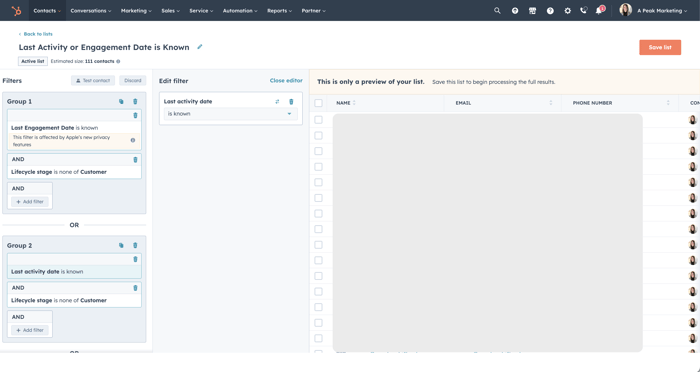Understanding Active vs. Static HubSpot Lists: A Comprehensive Guide
Lists are essential tools in HubSpot for organizing your contacts and ensuring your marketing efforts reach the right audience. Whether you’re sending personalized emails, automating workflows, or analyzing your contact data, HubSpot lists can be a game-changer.
In this guide, we’ll dive into the key differences between Active Lists and Static Lists, how to use them, and when to choose each one.
What are HubSpot Lists and Why Do They Matter?
In HubSpot, lists are used to organize your contacts based on specific criteria. These lists help you target contacts effectively and tailor your marketing messages, increasing the chances of engagement and conversions. With proper list segmentation, you can send the right message to the right contact at the right time.
Here’s how you can use HubSpot lists:
- Understand and segment your contacts
- Target recipients for marketing emails and campaigns
- Create reports based on contact data
- Set workflow enrollment and if/then branch criteria
- And much more!
Now that we understand the importance of lists, let’s dive into the two types of lists available in HubSpot: Active Lists and Static Lists.
What is an Active List in HubSpot?
An Active List in HubSpot is a dynamic list that updates automatically when new contacts meet the criteria you've set. It’s perfect for situations where you need a constantly evolving contact list that reflects the most recent data.
Key Features of Active Lists:
- Automatic Updates: Contacts are added or removed automatically based on whether they meet the list criteria.
- Multiple Criteria (Filters): You can create lists using up to 250 criteria (filters), allowing for highly granular segmentation.
- Groups & AND/OR Logic: You can combine multiple groups with AND/OR conditions to build more complex lists.
- Rolling Updates: Active lists are continuously updated, ensuring you're always working with the most up-to-date contact information.

When to Use an Active List
Active lists are ideal when you need a real-time, up-to-date list. You might use them in the following scenarios:
- Lifecycle Stages: Grouping contacts based on their current lifecycle stage (e.g., leads, customers).
- Engagement Tracking: Tracking contacts who have opened or clicked on a marketing email. This will update as more people engage with the email.
- Email Interactions: Tracking contacts who haven't opened a marketing email in the past month.
- Sales Interactions: Monitoring contacts who opened a recent sales email or clicked a specific call-to-action (CTA).
- Engagement Tracking: Contacts who have interacted with specific CTAs or campaigns (e.g., clicked on a CTA button).
Active lists are often used for email marketing campaigns, reporting, and automated workflows because they require real-time contact information.
What is a Static List in HubSpot?
A Static List is a snapshot of your contacts at a specific moment in time. Unlike active lists, static lists do not update automatically. Once the list is created and saved, it will not change unless you manually add or remove contacts.
Key Features of Static Lists:
- Fixed Membership: Contacts are added based on the list criteria at the time of creation, but they do not automatically update.
- Manual Management: You can manually add or remove contacts to or from a static list.
- Point-in-Time Lists: Static lists are perfect for capturing a particular set of contacts based on historical criteria.
When to Use a Static List
Static lists are useful when you need to capture contacts based on a specific point in time. Here are a few examples of when to use them:
- Event Tracking: Contacts who attended a specific event or trade show.
- Email Campaigns: Contacts who opened a particular email at a specific time.
- Imported Contacts: Lists created from CSV imports where contacts are not expected to change over time.
You might use static lists for segmentation based on past actions, campaign reporting, or historical data tracking.
Active List vs. Static List: Which One Should You Use?
Deciding between active and static lists depends on your marketing goals:
- Use an Active List if you need a dynamic, constantly updated list that reflects changes in real-time.
- Use a Static List if you need a fixed, point-in-time snapshot of your contacts for reporting or specific actions.
Example Use Case: If you’re creating a list of contacts who opened a recent email, an Active List will update as more people engage with the email. However, if you want to track contacts who opened that email on a specific date, a Static List would be more appropriate.
Can you convert a static list into an active list?
Yes! As of April 2025, HubSpot rolled out a feature update that allows you to change a static list to an active one. But there is a caveat, only static lists with filters are eligible to be converted to active lists. All you have to do is go to the static list, go to the Actions menu in the top right, and select to convert it to an active list. This feature is available to all hubs.
Best Practices for HubSpot Lists
To get the most out of your HubSpot lists, consider these best practices:
- Be Clear on Your Objective: Always define the goal of your list before creating it—whether it's for reporting, segmentation, or workflow automation.
- Segment for Relevance: Use HubSpot’s filtering options to create highly targeted lists that will improve engagement with your emails and campaigns.
- Test and Iterate: Periodically review and adjust your lists to ensure they’re still aligned with your marketing goals.
- Use Lists in Workflows: HubSpot lists can be integrated with workflows for automatic follow-up emails, task creation, or other automated actions.
Need Help Setting Up HubSpot Lists? Let’s Talk!
Understanding and using the right type of HubSpot list can significantly impact your marketing efficiency. Whether you’re building email campaigns, segmenting your contacts, or analyzing data, using the right list type ensures you're targeting the right people at the right time.
If you need assistance setting up or optimizing your HubSpot lists, feel free to book a free discovery call with our team. We’re here to help you maximize the power of HubSpot!



